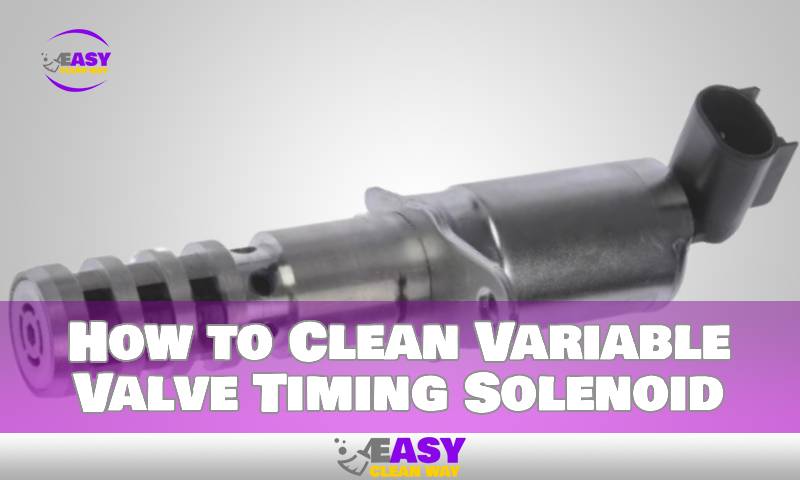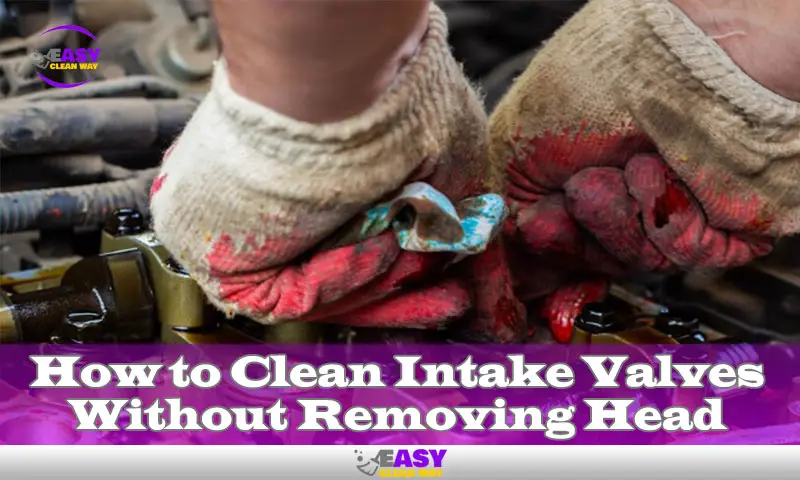To clean a variable valve timing solenoid, you must remove it and wash it thoroughly with a specialized cleaning solution. Use a brush to eliminate any grime residue.
The following procedure will assist in maintaining optimal engine performance. The variable valve timing solenoid is a critical component of the engine, responsible for adjusting the timing of the valves. This is accomplished by modulating oil pressure, which powers the solenoid.
Failure of this component can cause major engine issues, which is why it is important to keep it clean. This article will explain how to maintain your variable valve timing solenoid’s performance by cleaning it regularly.
What Is Variable Valve Timing Solenoid?
The variable valve timing solenoid, abbreviated as VVT Solenoid, is a vital component of the engine that helps optimize its performance. This small yet significant part of the engine controls the opening and closing of the intake and exhaust valves, ensuring that they open and close at precise moments.
If you’re experiencing issues with your engine’s performance, there’s a high chance that a dirty VVT solenoid is the culprit. In this post, we’ll guide you through the process of cleaning your VVT solenoid and keeping it in top-notch condition.
Definition Of VVT Solenoid
A VVT Solenoid is a mechanical component of the engine’s valve train system that works by regulating the camshaft’s timing. It is connected to the engine control module (ECM) and hydraulic valve lifters through a series of wires and connectors.
The VVT solenoid helps achieve the optimal balance between power, performance, and fuel economy.
Functionality Of VVT Solenoid In The Engine
The VVT solenoid is responsible for controlling the opening and closing of the intake and exhaust valves. A VVT solenoid is designed to adjust the camshaft timing in real time according to the engine’s driving conditions. The ECM sends a signal to the VVT solenoid, which affects the oil pressure in the hydraulic valve lifters and ultimately the position of the camshaft.
The engine can generate more power when the VVT solenoid is working efficiently.
Importance Of VVT Solenoid In The Engine’S Performance
The performance of the engine is directly related to the VVT solenoid’s condition. A dirty or faulty VVT solenoid can reduce the engine’s overall performance, decrease fuel efficiency, and even cause engine failure. A clean VVT solenoid ensures that the engine runs smoothly and that performance is optimized.
A well-maintained VVT solenoid can prevent expensive repairs and extend the engine’s lifespan.
The VVT solenoid is an essential component of the engine, and keeping it clean is crucial for your car’s overall performance. Make sure to follow the cleaning process or seek help from a professional mechanic. A little bit of maintenance can go a long way toward giving your car the best performance and a longer lifespan.
Signs Of Dirty VVT Solenoid

If your vehicle has a variable valve timing (VVT) solenoid, it can offer better performance and fuel efficiency. However, over time, it can become dirty, clogged, or damaged, leading to significant issues. In this section, we will discuss the signs of a dirty VVT solenoid that you should be aware of before it causes severe problems.
Bad Idling
A clean and functional VVT solenoid helps regulate the engine’s air and fuel mixture, ensuring smooth idling and trouble-free driving. A clogged or faulty VVT solenoid, on the other hand, can result in a rough idle, stalling, or stumbling when accelerating or decelerating.
Here are some signs of a bad idle VVT solenoid:
- Rough idling
- Engine hesitation
- Stalling
- Shaking or vibrating engine
Engine Lights
The engine control module (ECM) in your vehicle can detect malfunctions in the VVT solenoid and turn on the check engine light on the dashboard. The light indicates that there’s a problem with the engine system, and you should get the issue resolved immediately.
If you notice any of the following signs along with the check engine light, it could signal a dirty or damaged VVT solenoid:
- Reduced engine power
- Poor acceleration
- Misfire
- Poor fuel economy
Power Loss
A VVT solenoid is responsible for regulating the engine’s timing, power, and performance. If it becomes dirty or clogged, it can cause a decrease in engine power, resulting in a sluggish or unresponsive driving experience.
Here are some clues that your vehicle is experiencing power loss due to a faulty VVT solenoid:
- Slow acceleration
- Weak engine performance
- Unresponsive throttle
- Sound of clattering metal while starting the engine
Decrease In Fuel Efficiency
A dirty or clogged VVT solenoid can lead to a decrease in fuel efficiency, causing your vehicle to consume more fuel than necessary. With the rising price of fuel, it’s crucial to keep your car running as efficiently as possible.
You might experience some of the following symptoms if your VVT solenoid is dirty or malfunctioning:
- Reduced mileage per gallon (mpg)
- Engine running rich and consuming more fuel
- Frequent stops at the gas station
- The smell of fuel from the vehicle
If you notice any of these signs, it’s essential to get your VVT solenoid cleaned or replaced. A clean and functional VVT solenoid improves engine performance, reduces emissions, and increases fuel efficiency. Keep your vehicle running smoothly by regularly maintaining the VVT solenoid and other engine components.
How To Clean VVT Solenoid
Necessary Tools Required For Cleaning VVT Solenoid
Before you start cleaning the variable valve timing (VVT) solenoid, make sure you have the following tools:
- Safety goggles
- Latex gloves
- A socket wrench set
- A clean microfiber cloth
- A can of the throttle body or carburetor cleaner
Measures To Be Taken Before Cleaning VVT Solenoid
It’s important to take the following measures before cleaning the VVT solenoid to avoid any damage:
- Always work in a well-ventilated area
- Disconnect the battery to disable power to the circuit
- Locate the VVT solenoid
- Remove the electrical connector from the solenoid
- Remove the solenoid by unscrewing it with a socket wrench set
Steps Involved In Cleaning VVT Solenoid
Once you have taken all the necessary measures, you can start cleaning the VVT solenoid using these simple steps:
- Remove the VVT solenoid and place it on a clean work surface.
- Remove the screen from the solenoid and clean it with a clean microfiber cloth.
- Spray the throttle body or carburetor cleaner onto the solenoid’s metal surface and let it soak for a few minutes.
- Gently scrub the metal surface of the solenoid with a clean microfiber cloth until all the dirt or debris is removed.
- Use a clean microfiber cloth to dry the solenoid’s metal surface thoroughly.
- Reinstall the screen, connect the electrical connector, and reinstall the solenoid.
- Turn on the engine and make sure the VVT solenoid is working correctly.
Cleaning the variable valve timing (VVT) solenoid is a simple task that can improve your vehicle’s engine performance. By following these steps and taking proper precautions, you can easily clean the VVT solenoid and ensure its longevity. Remember to always wear safety goggles and gloves while working with solenoids and other car parts to avoid any accidents.
Best Practices For Maintaining VVT Solenoid

Variable valve timing (VVT) solenoids play an essential role in enhancing engine performance, allowing for better fuel efficiency and reduced emissions. To ensure the longevity of your vehicle’s VVT solenoid, you need to follow the best practices for maintaining it.
Here are the essential practices you should follow:
Regular Engine Maintenance
Regular engine maintenance is critical for the optimal performance of your vehicle, including the VVT solenoid. Here are the key points to keep in mind:
- Follow the manufacturer’s recommended maintenance schedule to avoid premature wear and tear of the VVT solenoid.
- To avoid engine clogging and harm to the VVT solenoid, replace the engine oil and oil filter according to the manufacturer’s recommendations.
- Use high-quality engine oil with the recommended viscosity and API (American Petroleum Institute) rating. Using low-quality oil may affect the solenoid’s performance.
Quality Fuel And Oil
Quality fuel and oil are essential for the VVT solenoids to function optimally and prevent engine damage. Here are some critical points to consider:
- Always use high-quality fuel that meets the manufacturer’s recommendations to prevent clogging and other issues related to poor fuel quality.
- Inspect the fuel injectors and keep them clean to prevent the build-up of deposits that may affect the VVT solenoid’s function.
- According to the manufacturer’s recommendations, change the spark plugs to maintain proper combustion and avoid engine damage.
Regular Inspection Of VVT Solenoid
A regular inspection of the VVT solenoid is vital to ensure it’s functioning correctly and to prevent any potential damage. Here are the essential aspects of a regular VVT solenoid inspection:
- Check for any signs of wear, tear, or damage to the VVT solenoid while doing regular engine maintenance.
- Ensure the solenoid is free from any debris and dirt buildup that may affect its performance.
- Check the electrical connections to the solenoid and ensure they are secure and free from dirt or corrosion.
Professional Engine Check-Up
A professional engine check-up is critical to detecting and repairing any VVT solenoid issues before they become a significant problem. Here are some essential points to consider:
- Schedule regular engine check-ups with a qualified mechanic to diagnose any VVT solenoid issues promptly.
- The mechanic should conduct a thorough inspection of the solenoid and replace it if necessary.
- Follow the manufacturer’s recommended maintenance schedule to ensure the VVT solenoid is functioning correctly.
Regular maintenance of the VVT solenoid is critical to ensuring your vehicle operates optimally. Follow the best practices outlined above, and you’ll get the best performance and longevity out of your car.
FAQs
What Causes VVT Solenoid Failure?
The most common reasons for VVT solenoid failure are oil contamination and electrical faults.
How Do I Know If My VVT Solenoid Is Bad?
Symptoms of a bad VVT solenoid include engine misfires, rough idling, poor fuel efficiency, and reduced engine power.
Can A Dirty VVT Solenoid Cause A Check Engine Light?
Yes, a dirty VVT solenoid can cause a check engine light to turn on due to its impact on engine performance.
How Often Should I Clean My VVT Solenoid?
It is recommended to clean your VVT solenoid every 60,000 to 100,000 miles, or as suggested by your vehicle manufacturer.
Conclusion
Keeping the variable valve timing solenoid clean is crucial for your engine’s optimal performance. The VVT solenoid is an important component that controls the engine’s airflow and fuel consumption. Failure to maintain it can lead to costly engine repairs or even engine replacements.
Start by identifying the solenoid location and using manufacturer-recommended cleaning products for the best results. Take note of the solenoid’s condition, as it may need to be replaced if it shows any signs of damage or excessive wear. Regularly clean your engine and VVT solenoid to ensure maximum performance, fuel economy, and smooth operation.
Don’t forget that proper maintenance is key to longevity and reliable engine performance. Keeping your VVT solenoid clean is easy and prevents avoidable problems down the line. Follow these steps to keep your engine running smoothly for years to come.

Hey there! I’m Clyde Funk, your Vehicle Clean Expert blogger. I’m on a quest to help you conquer the clutter in your Vehicle and embrace the joys of a tidy Vehicle.





